Desk Height Optimisation: Maximise Ergonomics and Comfort at Work
Updated On: October 24, 2025 by Aaron Connolly
Understanding Desk Height Optimisation
When you talk about desk height optimisation, you’re really just making your workspace fit your body and your tasks. Most folks end up stuck at desks that are too high or too low, which messes with your posture, makes you uncomfortable, and honestly just drags your productivity down.
What Is Desk Height Optimisation?
Desk height optimisation means setting your workspace at a height that fits your body and what you’re doing. The sweet spot? Your elbows should hit a 90-degree angle when you type or write.
For most people, you’ll want:
- Sitting desk height: 28-30 inches if you’re average height
- Standing desk height: 42-46 inches for the same group
- Adjustable range: Good for anyone between 5’0″ and 6’5″
Measure from the floor up to your elbow while you’re sitting comfortably. Your forearms should line up parallel to the ground when your hands are on the keyboard.
But it’s not just about the desk. Chair height, monitor placement, and where you put your keyboard all matter, too. You’ve got to look at the whole setup.
Why Desk Height Matters for Productivity
If your desk sits at the wrong height, your work suffers—there’s no way around it. A desk that’s too high makes you shrug your shoulders and strain your neck. Too low? You’ll end up slouching and crunching your spine.
Research points out that proper ergonomics can bump productivity by 15-20%. People tend to feel less wiped out and take fewer breaks when their desks actually fit them.
Physical benefits:
- Less back and neck pain
- Better blood flow
- Reduced eye strain
- Easier breathing
Why productivity goes up:
- You can focus longer without nagging aches
- Typing gets faster with your wrists lined up right
- No more constant shifting or stretching
Most of us clock 6-8 hours at our desks every day. Even tiny tweaks to your comfort can really add up over time.
Common Mistakes in Desk Height Adjustment
People often forget to measure their own bodies before adjusting their desks. Standard desk heights (29-30 inches) just don’t fit everyone, but most folks never bother to change it.
Common errors:
| Mistake | Problem | Solution |
|---|---|---|
| Only adjusting chair | Desk stays wrong height | Adjust both together |
| Ignoring monitor height | Neck strain sticks around | Raise screen to eye level |
| Skipping footrests | Feet dangle, bad circulation | Use an adjustable footrest |
Plenty of people set up their desk once and never look back. But your needs can shift—different shoes, new tasks, or just how your body feels that day.
Don’t trust “standard” measurements from online calculators without actually testing your setup.
Another big mistake? Focusing only on desk height and ignoring things like keyboard trays, monitor arms, or your chair. If you want real optimisation, you’ve got to think about the whole workspace.
Ergonomics and Healthy Posture
Good ergonomics means your workspace fits your body, not the other way around. That way, you avoid strain and the kind of injuries that sneak up over time.
If you keep your joints lined up and your wrists in a neutral position, you’re protecting yourself from repetitive strain injuries.
Principles of Ergonomics in Workspace
Ergonomics is all about designing your space to match how your body naturally moves. The idea is to cut down on muscle tension and joint stress, especially during long gaming or work sessions.
The main ergonomic principle? Keep your body in neutral positions—don’t twist or bend your joints at weird angles. Your spine should hold that gentle S-curve. Shoulders stay relaxed, not hunched or raised.
Where you put your equipment matters, too. Set your monitor at eye level to spare your neck. Keep your feet flat on the floor and your knees bent at about 90 degrees.
The 90-degree rule pops up everywhere:
- Elbows at 90 degrees for typing
- Knees at 90 degrees while seated
- Ankles at 90 degrees with feet flat
Bad ergonomics cause specific aches. You get neck pain from looking down at screens. Back pain shows up if you slouch or lean forward. Bent or twisted wrists? That’s just asking for trouble.
Try adjusting one thing at a time. Maybe start with your chair, then move on to desk height, then your monitor. Taking it step by step makes the process less overwhelming.
Maintaining Healthy Posture Throughout the Day
Healthy posture isn’t just about sitting up straight—it’s a habit, and it takes effort and movement.
For good seated posture:
- Keep your back against the chair
- Shoulders relaxed and level
- Head balanced above your spine
- Arms close to your sides
Even if you sit perfectly, staying still for hours makes your muscles tired. You’ve got to move around to keep blood flowing and stop stiffness from setting in.
How to keep moving:
- Stand and stretch every 30-60 minutes
- Shift your weight or change how you sit
- Do a few shoulder rolls or neck stretches
- Take quick walks now and then
Your chair matters a lot. Look for one with adjustable height, real lumbar support, and armrests that don’t make your shoulders creep up.
Slouching can turn into a bad habit fast. Try setting reminders every hour to check your posture until it starts to feel natural.
Monitor height changes your neck position. The top third of your screen should line up with your eyes when you look straight ahead.
The Role of Neutral Wrist Position
Keeping your wrists in a neutral position helps you avoid carpal tunnel and other repetitive strain problems that show up in gaming and office work.
Your wrists should stay straight—not bent up, down, or twisted sideways. That way, you take pressure off the nerves in your wrist.
Where you put your keyboard matters. Keep it low enough so your wrists don’t bend up when you type. Your forearms should stay parallel to the floor.
Mouse placement affects everything from your shoulder to your hand. Keep your mouse even with your keyboard. Let your upper arm hang naturally and let your forearm do the work.
| Position | Correct | Incorrect |
|---|---|---|
| Wrist angle | Straight | Bent up/down |
| Hand support | Forearm rests | Wrists on edge |
| Reach distance | Close to body | Stretched out |
Wrist rests can help during breaks, but don’t lean on them while typing or gaming. Your hands should float above the keyboard, supported by your forearms.
Game controllers are a different story. Hold them with loose shoulders and don’t grip too hard. Take breaks to stretch your fingers and wrists, especially during long sessions.
Determining Your Optimal Desk Height
To find your best ergonomic desk height, you’ll need to measure your body and use a few simple formulas. Whether you sit or stand, the goal is to keep your elbows at 90 degrees and your wrists straight.
Measuring for Sitting Desk Height
First, measure your height (no shoes) against a wall. Stand up straight with your heels, back, and head touching the wall.
Multiply your height in inches by 0.24 to get your ideal sitting desk height. If you’re 5’7″ (67 inches), that’s about 16.1 inches from the floor to your elbow.
Most ergonomic guidelines suggest sitting desk heights between 25-27.5 inches from floor to desktop. That covers most people and keeps your arms in the right spot.
Make sure your thighs are parallel to the floor when you sit. Your feet should rest flat on the ground or on a footrest.
If your ideal height isn’t in the standard range, look for a desk you can adjust. That way, you’ll hit your personal ergonomic desk height.
| Height | Ideal Sitting Desk Height |
|---|---|
| 5’0″ (60″) | 14.4″ elbow height |
| 5’6″ (66″) | 15.8″ elbow height |
| 6’0″ (72″) | 17.3″ elbow height |
Calculating Standing Desk Height
For a standing desk, multiply your height in inches by 0.53. So, if you’re 5’7″, your desk should be around 35.5 inches high.
Standing desk height usually falls between 35-47 inches to fit most people. Again, elbows at 90 degrees and forearms flat.
Set your monitor so the top of the screen is at or just below eye level. That’ll help your neck out during long stretches.
Try typing for a few minutes to test your setup. Your wrists should stay straight, not bent.
Start with 30-minute standing sessions. Add more time as your body gets used to it.
Anti-fatigue mats help a lot. They cushion your feet and keep you moving just a bit, which is good for your legs.
Customisation for Body Proportions
Formulas work for most, but not everyone has the same body proportions. If you’ve got longer or shorter arms, you’ll need to tweak your optimal desk height.
Measure from your elbow to the floor while standing naturally. That’ll give you a good starting point.
People with longer torsos sometimes need a slightly higher desk. Shorter torsos? Go a bit lower.
Quick test: Sit at your calculated height and let your arms rest. Your forearms should be parallel to the floor as you type.
Adjust up or down by an inch until it feels just right. Your shoulders should stay relaxed, not hunched.
If you share your workspace, an adjustable desk makes life easier for everyone. Electric models let you dial in the height quickly.
Adjustable and Height-Adjustable Desks
Height-adjustable desks let you switch between sitting and standing, which really cuts down on strain and helps you stay productive. These desks usually beat old-school fixed desks for health, and desk risers make a decent budget option if you’re not ready for a full upgrade.
Benefits of Adjustable Desks
Physical Health Improvements
Height-adjustable desks fight the risks of sitting too long. Studies say switching between sitting and standing can cut back pain by up to 54%.
Standing burns more calories than sitting. You’ll get better blood flow, which helps with focus and energy.
Changing positions throughout the day helps keep your spine and joints happy. You’re less likely to run into musculoskeletal problems.
Productivity and Workplace Benefits
People using sit-stand desks often feel less stressed and tired. Being able to move around more keeps you alert and on your game.
Standing meetings? They’re usually quicker and more focused. Height-adjustable desks also make it easier to work with others in flexible spaces.
Some companies have noticed fewer sick days related to discomfort after bringing in adjustable desks.
Choosing a Height-Adjustable Desk
Key Specs to Look For
Find a desk with a height range of about 26-28 inches (sitting) up to 45-46 inches (standing). That should fit most people.
Electric desks adjust quietly, so you won’t annoy your coworkers every time you move.
Size and Features
Most single-user desks range from 30″D x 48″W to 30″D x 72″W. If you use a lot of monitors, go bigger.
Built-in power outlets make charging devices easy and help keep cables tidy. Make sure the desk stays stable even at full height, especially if you use heavy gear.
Big team workstations (up to 202″ wide) are out there for group setups. They let several people work together, face to face.
Budget and Quality
Go for sturdy construction so your desk doesn’t wobble when you raise it. Check the weight capacity before piling on your equipment.
There are plenty of finishes, so you can match your office style. Quality adjustable desks cost more up front, but they’re worth it for your health and comfort in the long run.
Desk Risers and Alternative Solutions
Desktop Converters
Desk risers sit right on top of your existing desk and turn it into a standing workstation. They usually cost a lot less than a full height-adjustable desk.
Most converters give you a separate tray for your keyboard and a platform for your monitor. This helps you keep good posture when you switch between sitting and standing.
Budget-Friendly Options
Desktop risers are a solid way to test if you’ll actually use a standing desk. Since you can move them around easily, you don’t have to make any permanent changes to your workspace.
Some risers use gas springs for smoother height adjustment, while others stick to manual settings with set height positions.
Limitations to Consider
When you use a desk riser, you lose some of your original desk space. It can be tough to reach paperwork or fit extra equipment.
Desk risers also don’t hold as much weight as full standing desks. If you’ve got a heavy monitor setup, it might be too much for the converter.
Think of desk risers as a temporary step toward a full height-adjustable desk, not a forever solution.
Setting Up an Ergonomic Desk Arrangement
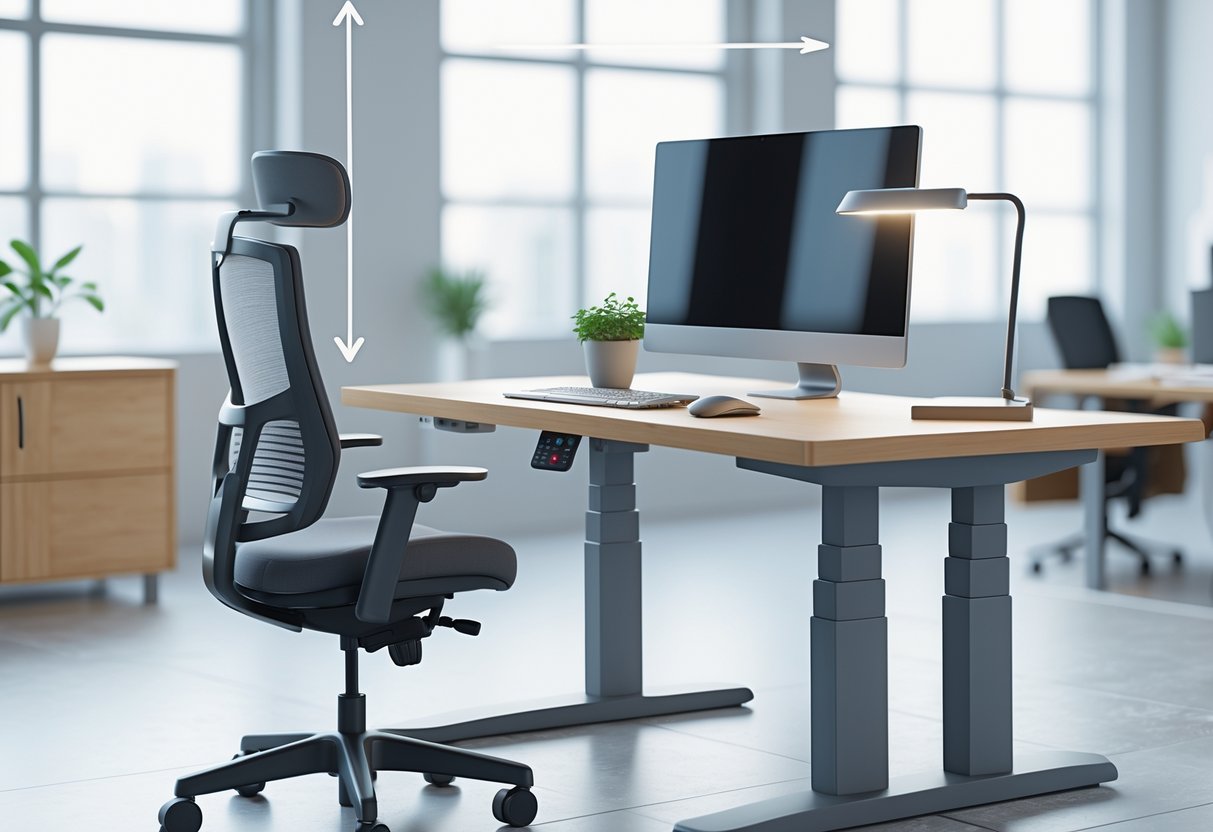
Getting your desk dimensions right is the first step toward healthy posture. A thoughtful setup can keep strain away and help you get more done.
The best arrangement lets your body relax naturally, so you never have to force yourself into awkward positions.
Ideal Desk Dimensions and Workspace Layout
When you plan out your desk dimensions, you’ll want to look at a few important measurements. Most desks stand about 28 to 30 inches tall, but you’ll want to check that this actually fits your body.
You need at least 24 inches of depth. That way, you have enough room for your monitor, keyboard, and whatever documents you’re using.
Desk width is important too. If you use just one monitor, 48 inches is usually enough. For two monitors, go for 60 inches or more.
Key measurements:
- Desk height: 28-30 inches (adjustable is best)
- Depth: at least 24-30 inches
- Width: 48-72 inches depending on your setup
You’ll want at least 24 inches of legroom width and 19 inches of depth. Your knees should move freely, not bump into drawers or desk supports.
Adjust your chair so your thighs fit under the desk. Leave a little gap—2 to 4 inches—between your thighs and the desk edge.
Creating an Ergonomic Workstation at Home or Office
Start your ergonomic workstation with the chair. Adjust the seat so your feet rest flat on the floor and your knees bend at a right angle.
Set your monitor about 20-26 inches from your eyes. The top of the screen should line up with your eye level or just below—no more craning your neck.
Essential positioning guidelines:
| Component | Position | Distance |
|---|---|---|
| Monitor | Eye level or slightly below | 20-26 inches |
| Keyboard | Elbows at 90 degrees | Close to body |
| Mouse | Same level as keyboard | Within easy reach |
Keep your keyboard and mouse at the same height. Try to keep your wrists straight and relaxed while you type.
Pick office furniture that supports your body. An adjustable chair with lumbar support can really help your back during long stretches at the desk.
If your desk sits too high, try a footrest. If you use reference materials, a document holder at eye level can save your neck some trouble.
Light matters more than you’d think. Position your desk to avoid glare on your screen, but make sure you can see your work without straining your eyes.
Chair and Foot Support for Desk Height Alignment
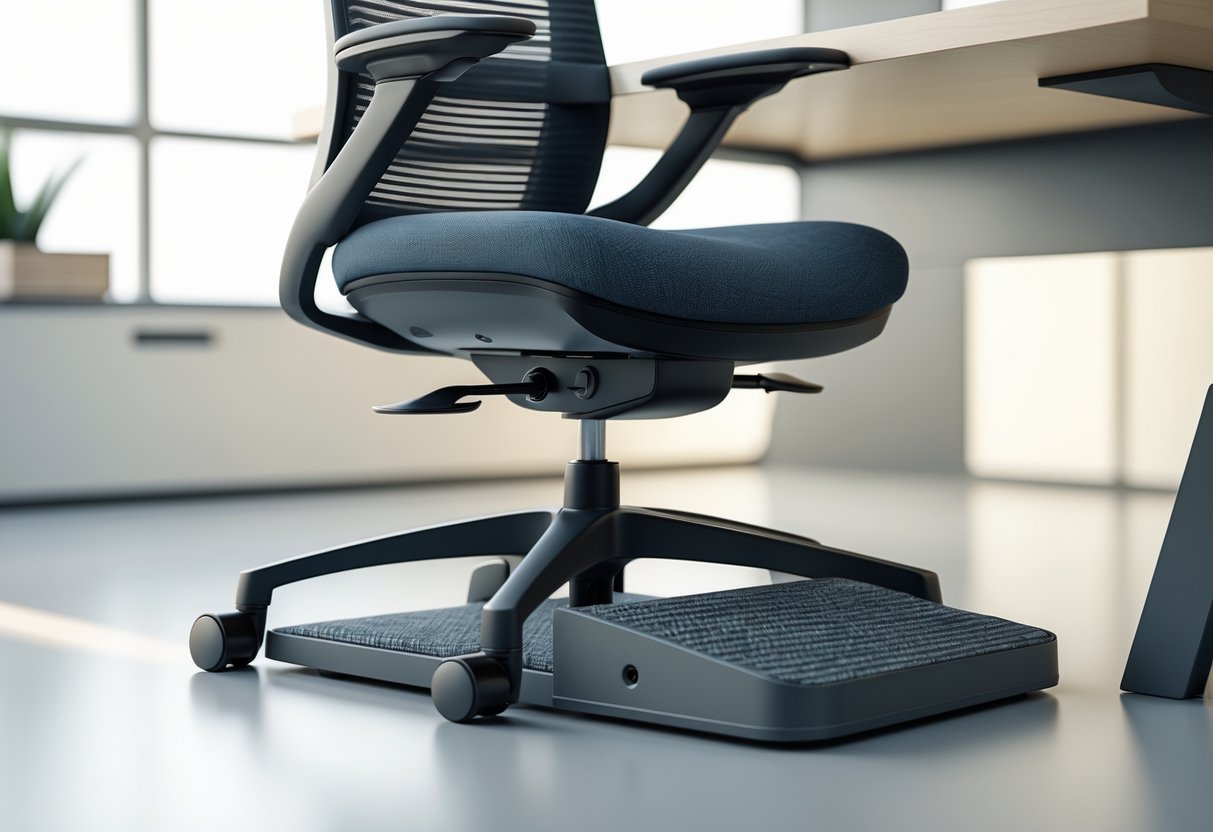
Your chair height and foot position work together to set up your desk alignment. If you get these right, your body keeps its natural angles and you’ll feel less strain over long days.
Adjusting Chair Height for Desk Compatibility
First, set your chair so your feet land flat on the floor. Your thighs should stay parallel to the floor or tilt just a bit downward.
When you rest your hands on your desk, your elbows should make a 90-degree angle. This keeps your shoulders loose and your upper arms relaxed.
Key measurements to check:
- Knees bent at 90 degrees
- Thighs parallel to the floor
- Elbows at desk level with arms hanging naturally
If your desk doesn’t adjust, start with your chair. If your feet can’t reach the floor, grab a footrest.
Most office chairs adjust between 16 and 21 inches high. That usually fits folks between 5’0″ and 6’2″ with a standard 29-30 inch desk.
Maintaining Feet Flat or Using a Footrest
Keep your feet flat—either on the floor or on a footrest. Dangling feet put pressure on your thighs and mess with your circulation.
If you’re shorter and your chair fits your desk but your feet don’t touch the floor, a footrest fixes that.
Footrest requirements:
- Adjustable angle (0-20 degrees)
- Non-slip surface
- Wide enough for both feet
- Height adjusts between 3-8 inches
Even if your feet touch the floor, a footrest can help keep your knees at 90 degrees, especially if you have long legs.
If you’re using a standing desk, an anti-fatigue mat takes the pressure off your feet and encourages small movements.
Lumbar Support and Comfort
Good lumbar support keeps the curve in your lower back and stops you from slouching.
Your chair’s lumbar support should fit snugly against your lower back. Aim for 6-8 inches above the seat.
Lumbar support checklist:
- Fills the gap between your back and chair
- Adjustable height and depth
- Firm but not rock-hard
- Supports your spine’s natural curve
No lumbar support? Use a small pillow or roll up a towel and tuck it behind your lower back.
Armrests should support your forearms just enough, not lift your shoulders. Let your arms hang naturally while you type.
Ergonomic Setup for Monitors, Keyboards, and Accessories
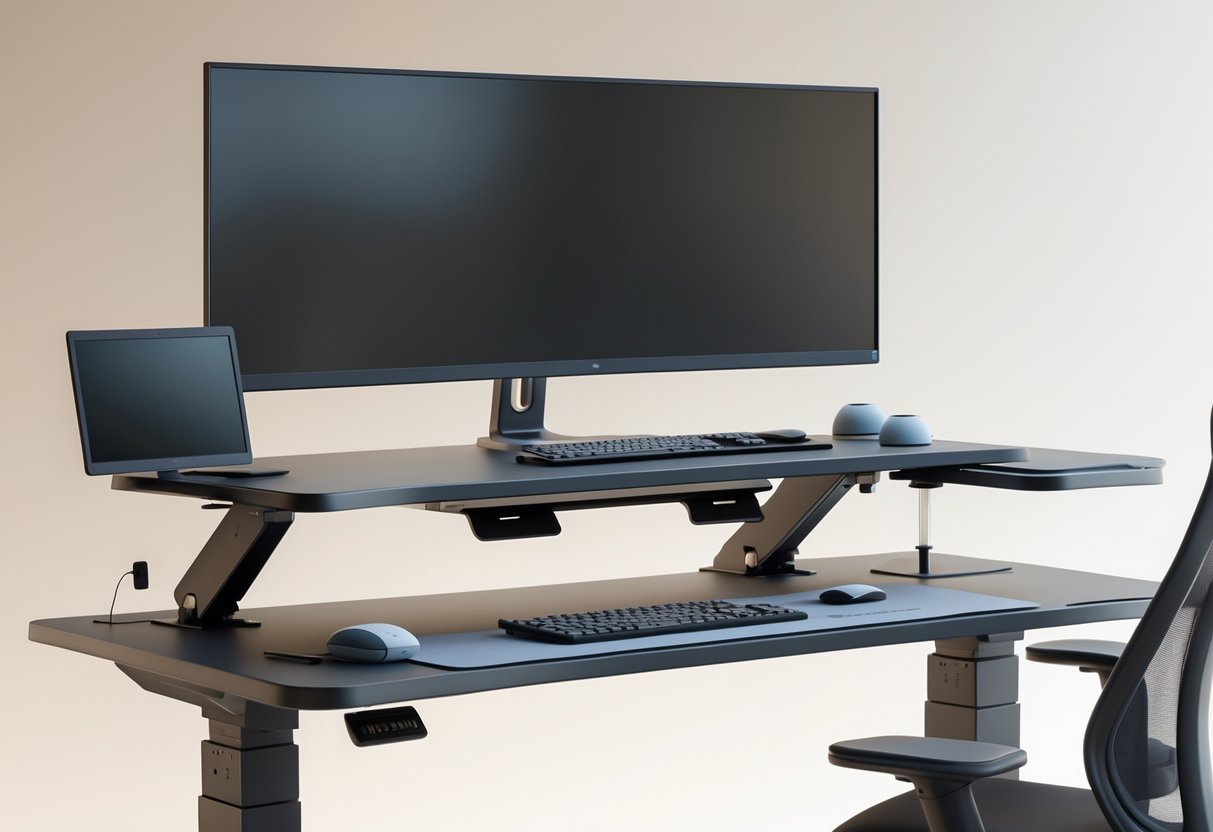
If you get your monitor at the right height, position your keyboard well, and use document holders, you can dodge neck pain, wrist aches, and tired eyes. These accessories work together to build a comfortable workspace that actually supports your posture.
Positioning Your Monitor and Using Monitor Arms
Keep your monitor at eye level so your neck stays neutral. The top of the screen should line up with your eyes when you’re looking straight ahead.
Most desks put monitors too low. That forces you to look down, which is a recipe for neck pain.
Monitor arms make it easy to lift your screen to the right spot. They clamp onto your desk and let you tweak height, tilt, and distance.
Key positioning rules:
- Screen distance: 50-70cm from your eyes (about arm’s length)
- Height: Top edge at eye level or a touch below
- Angle: Tilt back 10-20 degrees to cut glare
| Monitor Size | Recommended Distance |
|---|---|
| 21-24 inches | 50-60cm |
| 27-32 inches | 60-70cm |
| 34+ inches | 70-80cm |
Monitor arms also clear up space underneath for your keyboard, papers, or whatever else you need close by.
Keyboard Tray and Ergonomic Keyboard Options
Your keyboard’s height is just as important as your monitor’s. Keep your elbows bent at 90 degrees and your shoulders relaxed when you type.
A lot of desks sit too high for comfortable typing. A keyboard tray that slides out below your desk can bring the keyboard down to the right level.
Try to find trays that let you adjust both the height and the tilt. Some even include a mouse platform so everything stays on the same plane.
Ergonomic keyboards can really help with wrist strain:
- Split keyboards let your hands fall naturally
- Curved ones match your finger arc
- Low-profile keys mean less finger movement
Keep your wrists straight while typing. Don’t rest them on hard surfaces—if you use a wrist rest, only do it when you’re not typing.
Set your keyboard right in front of you, lined up with your body. Keep your mouse right next to it at the same height.
Incorporating Document Holders Effectively
Document holders stop you from constantly looking down at papers. That repeated motion can really strain your neck.
Stick document holders between your keyboard and monitor, or just to the side at the same height. This way, you keep your reference materials at eye level.
Types of document holders:
- Desktop stands for the occasional paper
- Clamp-on holders that attach to your monitor arm
- In-line holders that sit right between your keyboard and screen
If you work with papers a lot, put the holder as close to your monitor as you can. That way, your eyes don’t have to travel far.
Adjustable holders are best, so you can tweak the angle depending on the light. Tilt your documents back a bit to avoid glare from overhead lights.
Some monitor arms even come with built-in document clips, which makes for a tidy ergonomic workstation.
Optimising for Standing and Sit-Stand Workstations
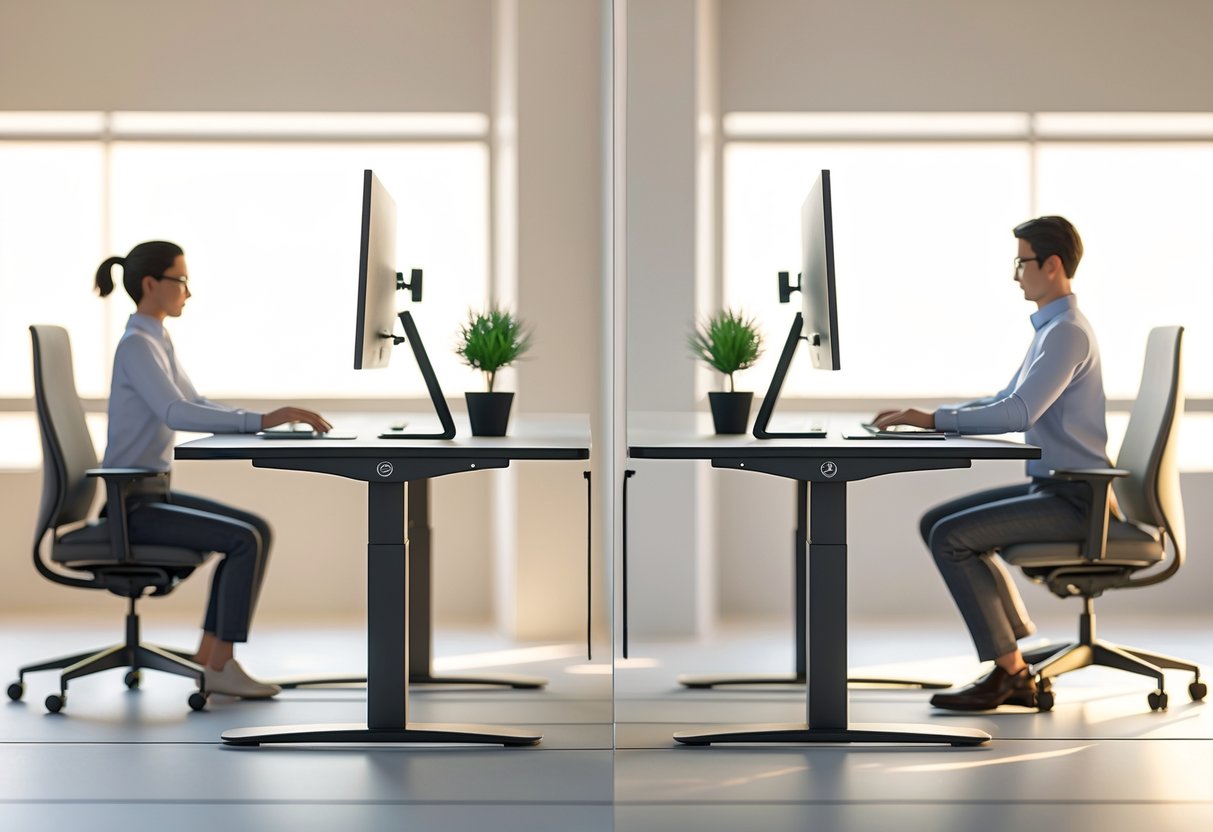
Standing desks need careful height adjustments to keep your posture neutral. Switching between sitting and standing helps you avoid getting tired or sore. Adding comfort accessories and moving around a bit can make standing work much more enjoyable.
Setting Standing Desk Height Correctly
You want a 90-degree angle at your elbows when you type at a standing desk. Most people end up with a desk height somewhere between 38 and 42 inches.
Stand up straight, let your shoulders relax, and bend your elbows to 90 degrees. That’s your optimal desk height.
Keep your wrists straight and neutral while you type. Put your monitor at eye level so you don’t crane your neck.
Here’s a quick guide:
| Your Height | Recommended Desk Height |
|---|---|
| 5’0″ – 5’3″ | 38″ – 40″ |
| 5’4″ – 5’7″ | 40″ – 42″ |
| 5’8″ – 5’11” | 42″ – 44″ |
| 6’0″+ | 44″ – 46″ |
But don’t just follow the chart—double-check with your own elbows. Arm lengths vary a lot.
Alternating Between Sitting and Standing
Experts now say you should stand for at least 30 minutes every hour to get real health benefits. The old advice of 15 minutes per hour just doesn’t cut it.
If you’re new to standing desks, start slow. Try 15 minutes of standing at a time and work up as your body gets used to it.
A simple routine might be:
- Stand for 30 minutes
- Sit for 30 minutes
- Take a 5-minute walk
Don’t stay still too long. Even when you’re standing, shift your weight or change positions every 15-20 minutes.
Pay attention to how you feel. Some tiredness is normal at first, but if you feel sharp pain, your setup might be off.
Tips for Prolonged Standing Comfort
Anti-fatigue mats cushion your feet and make standing much more comfortable. Look for ones with edges that won’t trip you up.
Shoes really matter. Wear supportive shoes with good arch support. Skip high heels or totally flat shoes.
Keep a little bend in your knees instead of locking them straight. This helps your blood flow and keeps your joints happy.
A footrest or rail lets you prop up one foot at a time, which can take pressure off your legs.
Move around every 30 minutes. Try calf raises, ankle circles, or just walk a bit. It keeps you from getting stiff.
Drink plenty of water and make sure your lighting is good to avoid fatigue while you’re standing.
Monitoring and Maintaining Ergonomic Positioning
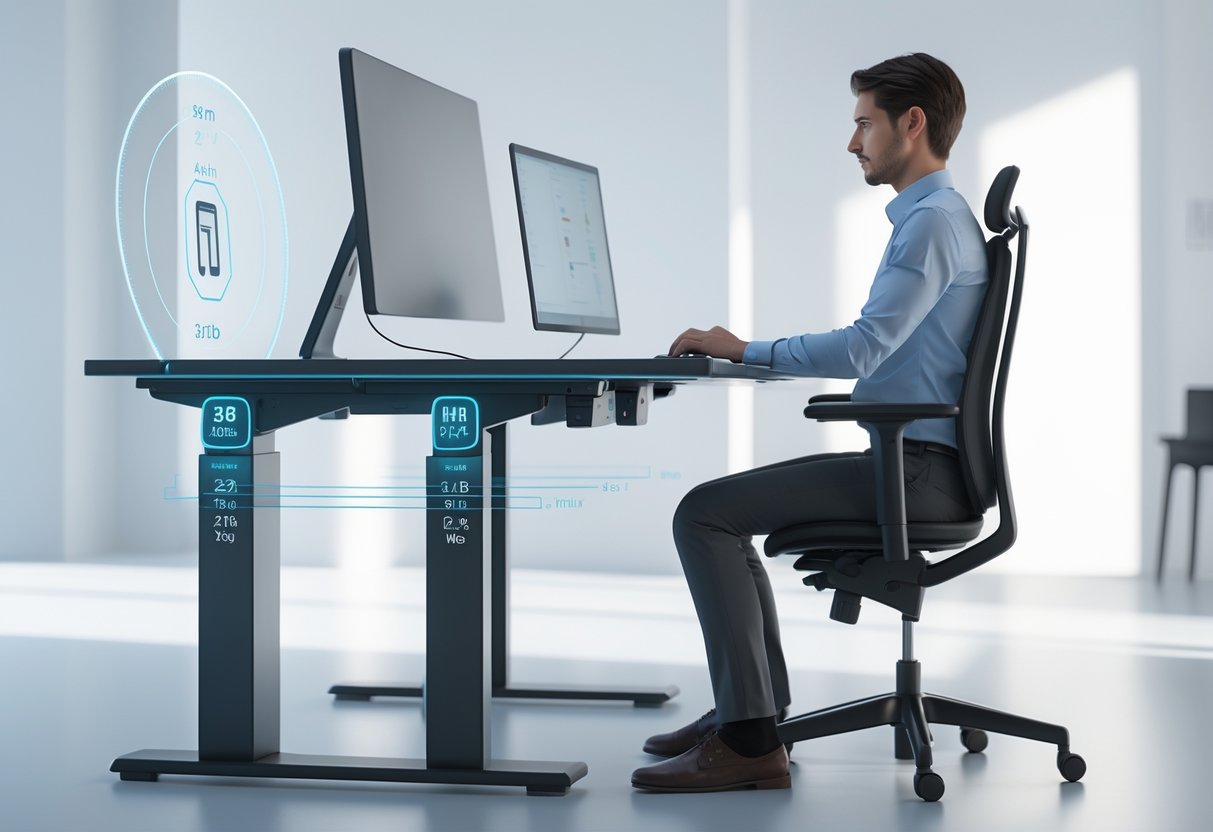
Check your workspace setup regularly. A few small tweaks can help you stay comfortable and avoid pain during long workdays.
Routine Assessment of Desk and Chair Settings
Weekly posture checks can help you catch issues before they turn into aches. Set a reminder every Monday and give your setup a quick look.
Sit down like you normally do for work. Are your feet flat on the floor? Knees at 90 degrees?
Check your elbows while typing—aim for that 90-degree angle. If it’s off, tweak your chair height before anything else.
Glance at your monitor. The top should line up with your eyes, or maybe a little lower. That way, your neck doesn’t get stiff after hours at the desk.
Monthly equipment reviews are honestly worth the time. Try out your chair’s height adjustment and lumbar support.
See if your keyboard and mouse still sit at the right height. If something’s worn out and won’t adjust, it’s probably time to swap it.
Jot down any discomfort you notice during the day. Which body parts hurt? When does it start? These notes make it easier to figure out what needs fixing.
Adapting to Changes in Daily Workflow
Different tasks, different positions. Writing? You might want your desk a bit higher than for typing. Drawing or design? A tilted surface usually feels better.
When you switch tasks, take 30 seconds to adjust your setup. Pull your monitor closer for detail work, push it back for general stuff.
Standing desk fans should change positions every half hour or so. Start with short standing sessions and slowly increase as you get used to it.
Set up position reminders on your phone or computer. These little nudges help you remember to check your posture.
Keep the things you use most within arm’s reach. No need to stretch awkwardly and mess up your ergonomic alignment.
Pay attention to which activities leave you sore. Maybe heavy email days need a different setup than video calls or creative projects.
Adjust your lighting as your tasks change. Bad lighting makes you lean in and ruins your posture.
Dealing with Cable Management and Workspace Organisation
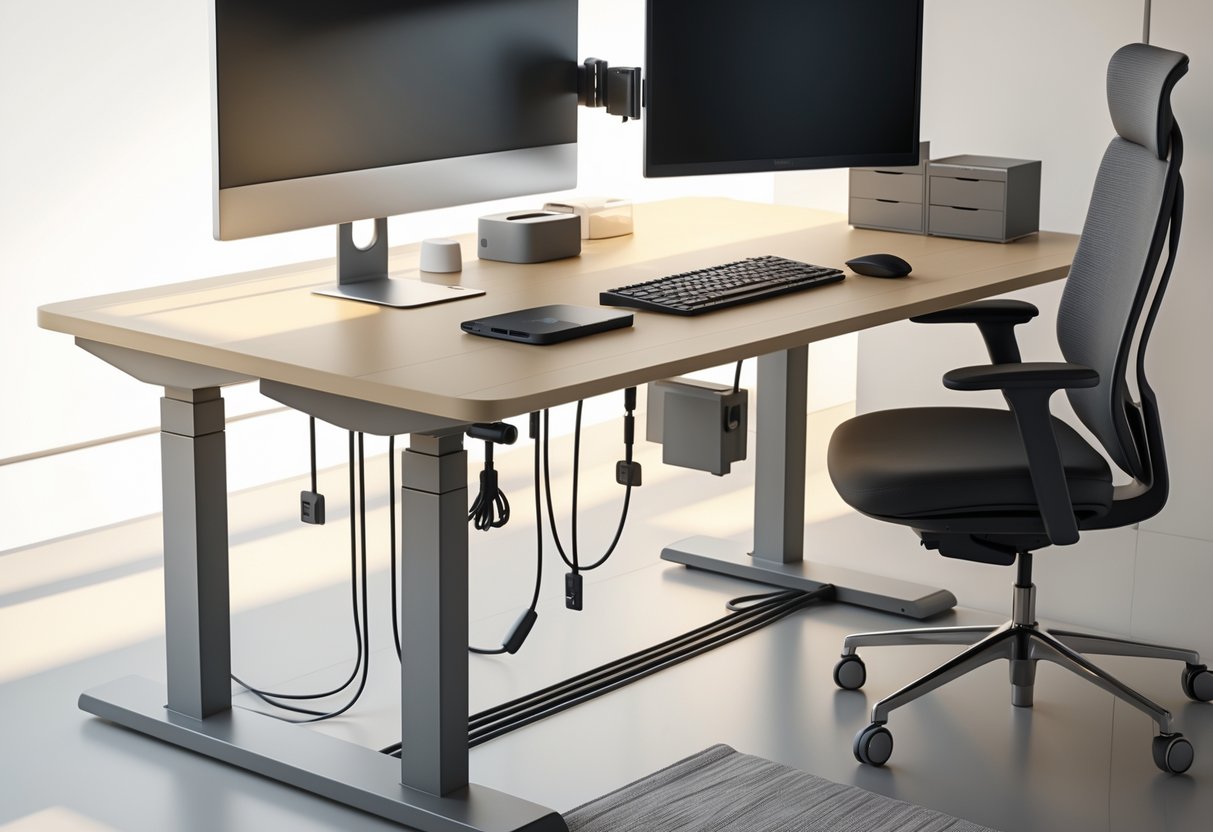
When you route cables neatly and keep your workspace tidy, your desk just works better. Good cable management stops trip hazards and helps you stay in the right position. Organised storage keeps essentials close by.
Effective Cable Management Techniques
Standing desks can make cable chaos. Cables need to move up and down without pulling or tangling.
Under-desk cable management is a must. Mount cable trays a couple inches under your desk so they move with it and keep cords tucked away.
With height-adjustable desks, service loops are a lifesaver. Leave a bit of slack near connection points so cables don’t get yanked when you move the desk.
Desk-mounted power strips are just better than floor ones. Attach your main power strip under the desk with brackets so it stays put at any height.
Pay attention to the desk-to-floor cable run. Use vertical cable spines or flexible sleeves to guide cords from the floor up. These expand and contract as your desk moves, keeping things tidy.
Bundle similar cables with velcro ties or spiral wraps. Separate power and data cables to avoid interference. Group cables by where they go—monitors together, peripherals together.
Test your setup by running the desk through its full range. Watch for tight spots or extra slack that could snag.
Decluttering to Support Ergonomics
Clutter messes with your posture and distracts you. It’s just not worth it.
Keep your main work zone clear. That’s the space right in front of your keyboard and mouse. Store things you use a lot—like your phone or notebook—within easy reach.
Drawer organisers make life easier. Sort out small stuff like cables and pens so you’re not digging through a mess and twisting your body.
Set your monitors at the right distance and make sure cables or gear aren’t in the way. Ditch decorations that don’t actually help you work.
Create storage zones for stuff you don’t use every day. Keep weekly-use items nearby, but daily essentials should be right at hand.
Do a daily reset. Spend five minutes at the end of the day putting things back where they belong. It keeps your space ergonomic without big cleanup sessions.
Try vertical storage—monitor stands with shelves or wall-mounted options. These open up desk space while keeping things handy.
Addressing Common Desk Height Issues
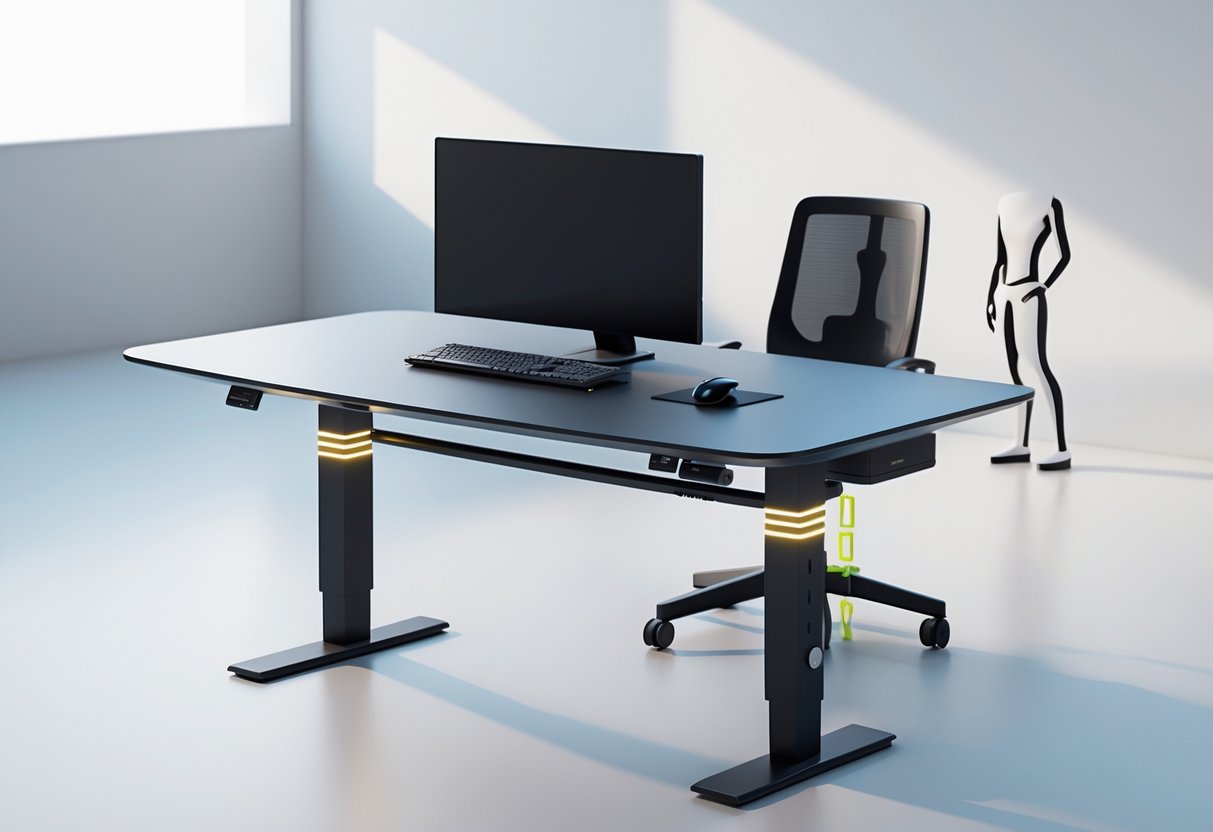
Lots of office workers struggle with desks or chairs that just don’t fit. You don’t always need to buy new furniture—desk risers and a few tricks can really help.
Solutions for Fixed-Height Desks
Fixed desks show up everywhere, but they’re rarely perfect for everyone. If your desk is too low, you’ll end up hunched over and sore.
Desk risers are the fastest way to bump up your workspace. Set them on top of your desk to raise your monitor, keyboard, and mouse.
Pick adjustable risers so you can fine-tune the height. Many cost between £30-80 and lift your setup by 10-20cm.
Need something cheaper? Stack some sturdy books or boxes under your monitor. Just make sure they’re stable.
Monitor arms come in handy for screens that sit too low. Clamp one to your desk and adjust the height, tilt, and distance as you like.
If you need your desk lower, try removing drawers or installing a keyboard tray underneath.
Compensating for Mismatched Office Furniture
When your desk and chair don’t match, small tweaks can really help. Start with your chair—it’s usually easier to adjust.
Seat cushions can boost your sitting height by 5-10cm if your chair’s too low. Go for a firm, ergonomic cushion that won’t flatten out.
If your chair sits too high and won’t go lower, use a footrest. Your thighs should stay parallel to the floor, even if your feet need support.
Adjustable keyboard trays fix a lot of height mismatches. Mount one under your desk to keep your keyboard at elbow height and your monitor at eye level.
If nothing fits right, talk to your employer about an ergonomic assessment. Many companies will get you the right gear to avoid injuries.
Frequently Asked Questions
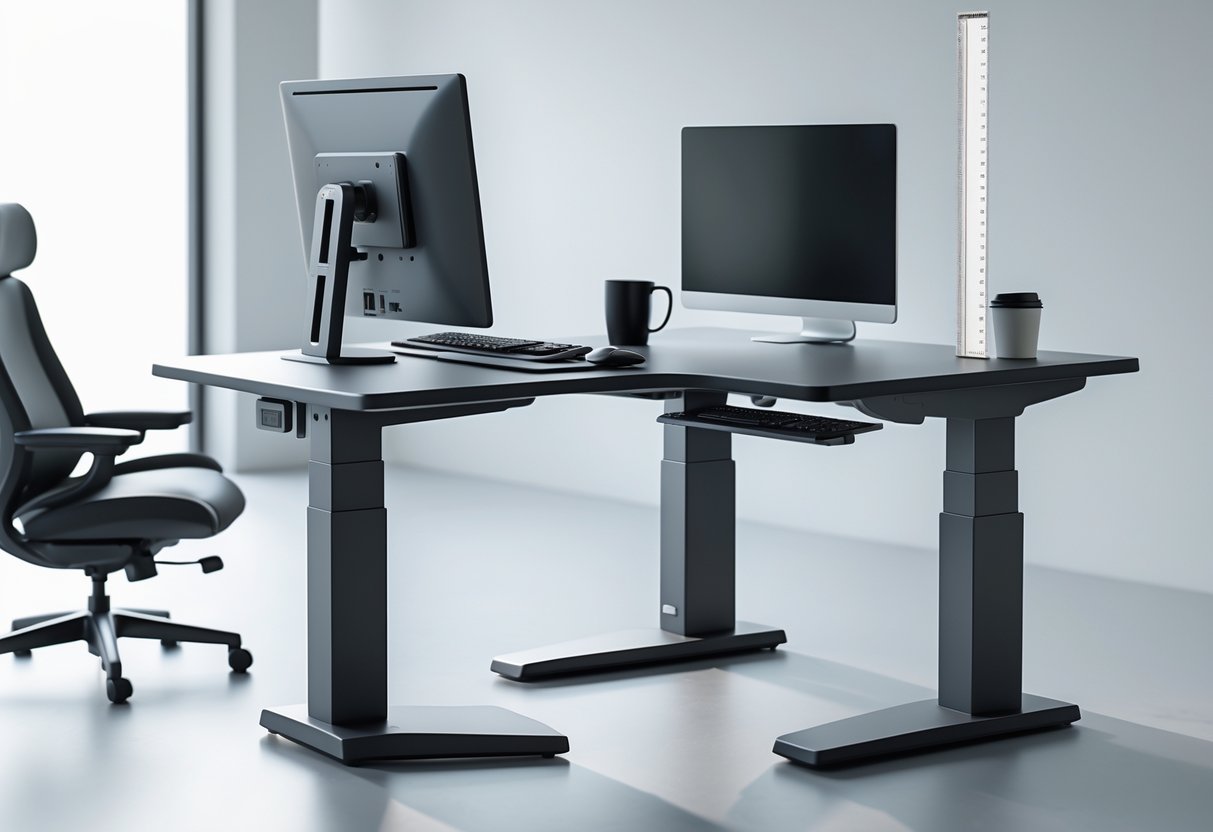
Figuring out your desk height means looking at your body, not just the furniture. Most people need personalised setups instead of standard heights to stay comfy through long workdays.
What’s the best way to determine the ideal desk height for my height?
Sit in your chair, feet flat, knees at 90 degrees. Rest your arms so your elbows also hit that 90-degree angle on the desk.
Measure from the floor to the bottom of your elbows in this position. That’s your ideal desk height for typing and writing.
Make sure your thighs are parallel to the ground. If not, adjust your chair and check your elbow height again.
Can you share a guide on how to set up a workstation that’s comfortable for sitting and standing?
When sitting, line up your desk so your elbows bend at 90 degrees as you type. Keep your monitor at eye level, about 20-30 inches away.
Standing? Raise the desk so your elbows still bend at 90 degrees—usually between 38-42 inches for most folks. Keep your wrists straight, not bent up.
Switch between sitting and standing every half hour or so. It keeps you from getting stiff and helps you focus.
If your feet don’t touch the floor when sitting, grab a footrest. When standing, an anti-fatigue mat feels great on your legs.
What is considered the standard desk height for a comfortable working posture?
Most office desks sit at 73cm (about 29 inches) tall. That works for people up to 6 feet tall with an adjustable chair.
But honestly, standard heights don’t fit everyone. Taller folks usually need desks at 30-32 inches, while shorter people might want 26-28 inches.
Match your desk to your elbow height, not just a number. Your body is more important than averages.
How can I adjust my desk height to prevent discomfort during long work hours?
Check your posture every hour and make quick adjustments. Your shoulders should feel relaxed—not hunched or slumped.
Keep your wrists straight while typing. If they bend up or down, adjust your desk height.
Take breaks to stand, stretch, or walk. Even with the perfect desk, sitting still too long makes you stiff.
Use a document holder to keep papers at eye level. That way, you won’t crane your neck looking down all day.
Is there a recommended desk height that suits most individuals, or should it be tailored?
Always tailor your desk height to your body. Standard sizes are hit or miss.
Your arm, torso, and leg lengths all matter. Two people the same height can need totally different desk setups.
Adjustable desks are the best bet because they fit different users and tasks. Fixed desks only work if you happen to match them.
Think about your daily tasks, too. Writing by hand might need a slightly different height than computer work.
Could you provide some tips on how to choose the right desk height for ergonomic work practices?
Start with your elbows—they’re honestly the best guide for figuring out both desk height and chair adjustment.
Look for desks that let you adjust the height enough for both sitting and standing. Most folks need somewhere between 10 and 12 inches of range.
Try out a few different setups before you settle on one. Something that feels fine for a few minutes might end up being uncomfortable after a while.
If you share your workspace with others, it’s worth getting a good adjustable desk. Manual ones are cheaper than electric, but you’ll have to put in a bit more effort when you want to change things up.

